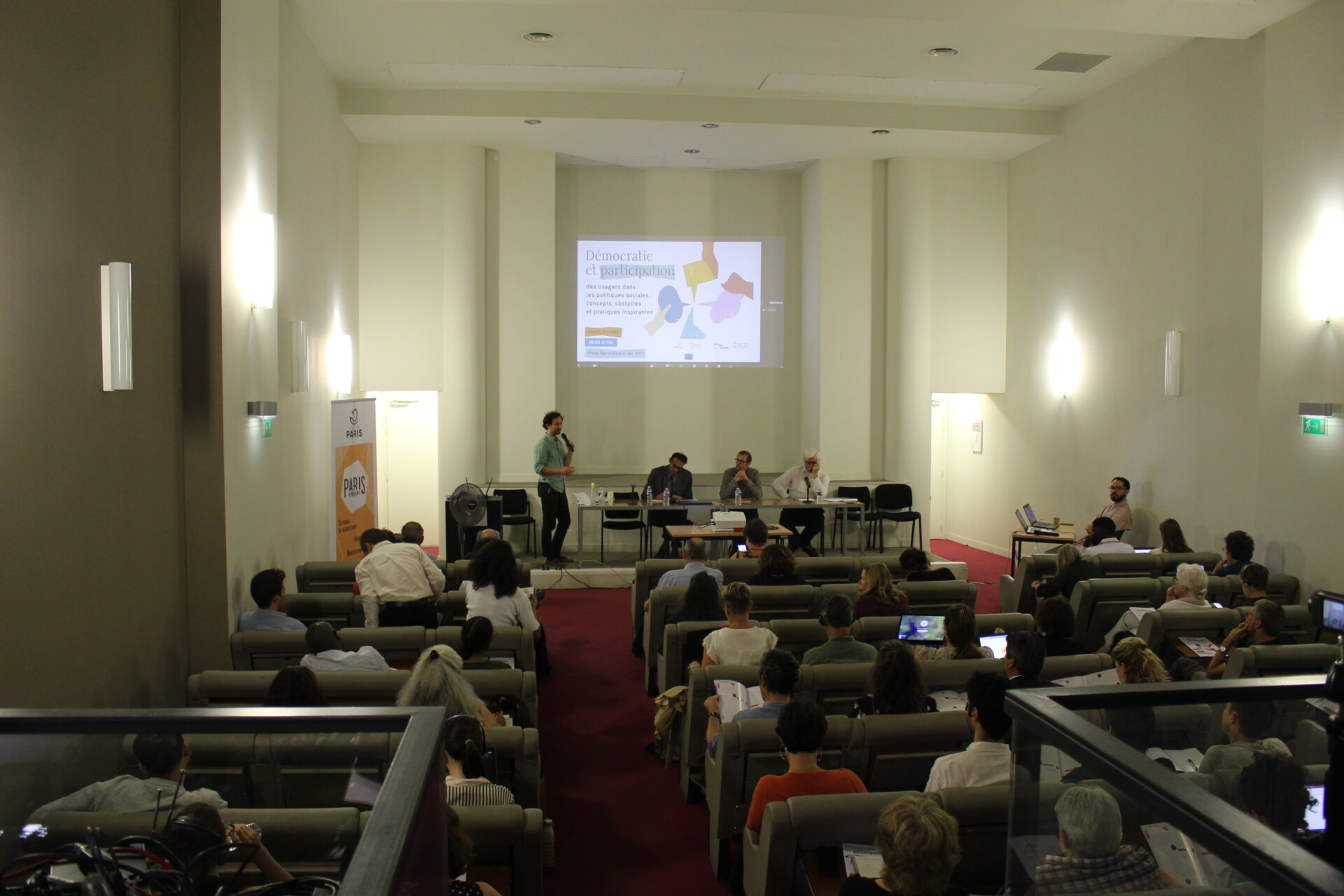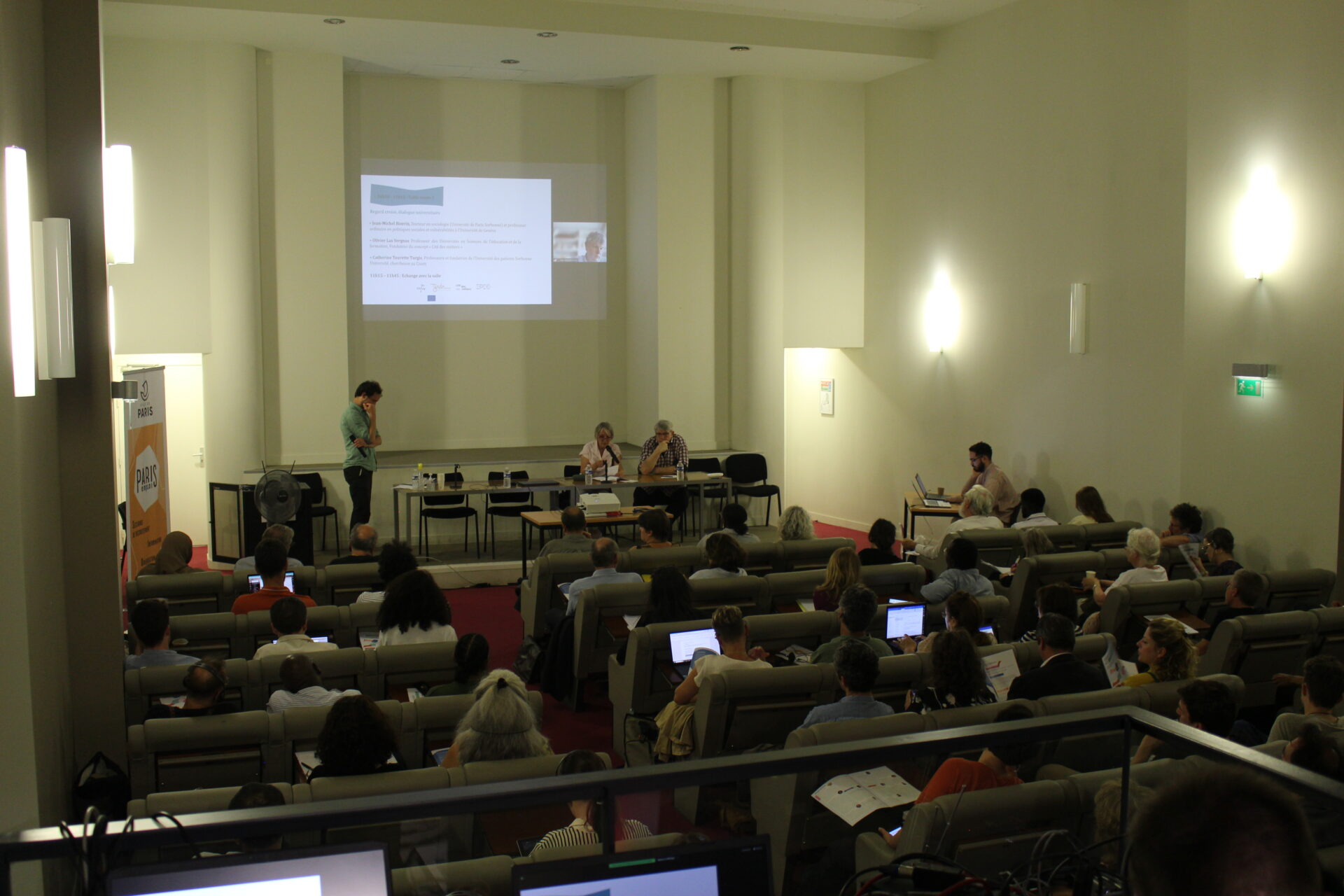
Involve’s Citizen Lab (CL) will take place once a year. Each time, we invite experts and street experts to enrich Involve’s research, methodologies, practice and impact.
In this blog, we summarize the Paris Citizen Lab. In Paris, Involve invited (street) experts to talk about their experiences with participation in social and public services.
Key messages:
– participation provides broad democratic support for local society and broad support for society per se.
– participation should be applied to all public, semi-public and social services.
– participation starts best from the bottom up
– participation should not be hindered by top-down regulations; these regulations should be subject to participation scrutiny
– resources for participation can be both public and private (from the users)
– participation must be guided but remains in the hands of the user

Why is participation so necessary?
Jonathan Stebig, director of GRDR, opened the Citizen Lab. He clarifies the place of the CL’s theme: the impact of the reconfiguration of our societies, and therefore of our relationship with public services, invites us to recompose forms of participation, to compensate for the shortcomings of public services, or to find answers in times of ecological, governmental or health crises.
Rafaël Ricardou (Head of the Cité des métiers/ Cité de la Santé Department) welcomed the panellists and the audience. He reminds everyone that the Cité is a resource center based on a frame of reference that requires co-construction. The Cité works with reference frameworks for professional practices and governance, which involve thinking about user participation. He questions the uprisings of young people in France: why are public services the first target in these areas? Perhaps because these services meet a social need that has been dismantled? A question for the panel.
Jean Marc Pradelle (president de GRDR) talked about the experiences of GRDR with participation. Participation is at the core of GRDR: the association has privileged its proximity to the public, who have been seen as development players since GRDR’s origins, and this continues today through our support for national associations, and our feedback to public policy. Since the 2000s, GRDR has largely focused on integration, while maintaining a way of doing things that is based on the experience of users.
Michel Debruyne (Involve project coordinator, Beweging vzw) explains the Involve project and the key terms of the research project. The key is: how do people, who are no longer mobile or unable to have their voices heard, get involved in public policy? Social and public services are at the forefront of the political community and are a marker of their appreciation. Trust in society depends thus on trust in public and social services. Involve wants to open the debate on these services and the role of participation. This debate is also an experiment in politicizing public services.
The first panel with experts discussed the need of participation and the need of social services.
The first panel
Jean-Michel Bonvin (Université de Paris Sorbonne, Université de Genève) opened the first panel. He shows that there exists a paradoxical gap between expectations and difficulties encountered in accessing social services. Public services can even make people more vulnerable. They are not fulfilling their missions. What’s more, the very people who are supposed to be calling on social services are turning away from them. How can we bridge this gap, how can we re-establish trust into these services?
Services are defined by how they organise the access to the service, the quality of the service and the way how services are delivered.
Services are creating thresholds to the access. Users have to prove that they are entitled to benefits and services. It’s a question of eligibility, but also of merit. Social services replicate the mechanisms of tyranny based on merit. The consequence is that services through these thresholds create exclusion of the most vulnerable or create self-exclusion. Non-take up is an answer from vulnerable people to these barriers.
The quality of services is another barrier: what resources are still available? Are they sufficient? Are there enough personnel? Have the personnel enough time to listen to the user? Quality of the service is really key for people to want to use it.
The third criterion is the delivery of social policy: is there a willingness to apply or to co-construct projects? The answers will vary according to the vision of the people on the ground. It’s a question of relying on them to implement viable policies.
Together, these criteria give us a framework to elaborate a real genuine social service and policy.
Olivier Las Vergas (Université des Sciences de l’éducation et de la formation, Founder of Cité des métiers) elaborated on this introduction and referred to his experiences with the Cité des métiers.
When discussing social policies and social services, it should be clear what social issues we are talking about. This raises as many questions about employment, the health crisis and identity papers, as it does about the most vulnerable people in terms of health and homelessness. The scales of participation are thus quite different from one area to another. Questions of welcome and user experience are not part of participation. So, the type of participation depends on the social issue.
His experience with the Cité des Sciences et de l’Industrie shows that it is possible to reach a wider public. Tapping into people’s concerns about health or employment: it’s a question of empowering users to use their reflexivity. What can we do with their feedback? Is it a customer experience, a frame of reference, or really reflexivity from the user? In his experience, even after all these years, participation initiatives never exceed 15% of all social services. The question is, after all the positive experiences, why is it still necessary to talk about the need for participation??
Catherine Tourette Turgis (Université des patients de la Sorbonne, Cnam) closed the first round. Her idea of participation comes from her personal experience as a child of the DASS (direction départementale des Affaires sanitaires et sociales) and in LGBT feminist struggles. Reflection has always navigated between research objects and personal experience. The aim was to create expertise and capitalize on experience to open up a scientific and institutionalized field. The opening of the Patients’ University was itself an experiment. This made it possible to start from innovation on the part of the people concerned, to create frames of reference and capitalize on their experiences.

The second panel
The second panel provided an overview of practices of citizen participation.
Patrick Debucquois (European Committee of Non-profit Organisations, CEDAG) stressed the importance of the role of associations. Most service providers are associations. In associations, participation is foreseen, is even the core of their organisation. In associations people learn what democracy means. The problem is now that the legislation is evolving in the direction of associations as companies. Then raises the question if there are still enough mechanisms for managing conflicts of interest between the role as a company, the role as a voluntary organisation, the non-profit goal of the association. And what is the interest of users in decision-making in these organisations.
We must overcome the crisis of representativeness. We only want to be represented by ourselves, whether in politics, by our employers or by our unions, and as a user in a social service. We must again create real associations based on cooperation and joint decision making.
Carole Ferrini (HR Manager, Régie de quartier du 19e) talked about her experiences of participation in different neighbourhoods. There are 130 “régies de quartier” in France working in the field of social integration and popular education. They bring together elected representatives, residents and social landlords, with a majority of residents. Residents are employed to improve living conditions in their neighborhoods (maintenance, cleaning). Residents are also members. It’s a model that favors co-management of a territory and its re-appropriation by residents, as well as enabling them to share their experience with other territories. The difficulty remains mobilization. Residents sometimes lose interest. It remains complicated to involve all profiles of residents in positions on the association’s Board of Directors or Executive Committee.
Haya Diakite (President of Rêv’elle toi) defended co-construction from the bottom up.
She experiences a dichotomy between users and funders (like governments). Social workers are the ones caught between the two and experience the paradoxes that derives from this paradox. Top-down, guidelines on how to work together are unleashed on neighborhoods and people, guidelines that are disconnected from people and their problems. Thus, people are pushed into a system (a particular model of care) that doesn’t fit them. This model also makes them feel guilty.
The creation of Rêv’elle toi is based on the voices of local people. The notions of “going out to the people” and “co-construction” are no longer a subject for reflection, as we start from the experience of the people themselves. It’s a way of making people actors in their own problems, without relegating them to the status of assistants. We need to give legitimacy back to the user and stop using a funding logic. This is also a key to mobilization, which ultimately compensates even for the lack of funding.
Thomas Sannié (President, France Asso Santé IDF) closed the second panel with his experiences of participation in care services.
We need to stop doing things for people and start working with people. There are user representative bodies, but they are not enough. We cannot speak of real participation. There is no collaboration. Health care is a good example of this. Protocols are developed independently of user needs and experiences.
For the time being, the challenge of patient feedback lies with associations. It is these associative movements that enable change, because they define expectations and needs in a collective movement. There is the expert in the disease and the expert in living with the disease, and it’s a question of bringing the two together. It’s a relationship that has to be set up to manage the balance of power/asymmetry of knowledge, to establish the values/principles of this partnership to deliberate to make collective decisions.
The audience took the opportunity to go deeper into the various readings. They stress the need of putting associations at the heart of power issues with funders. Some warned that it’s dangerous to turn away from the State altogether and pass the burden of change solely on to users, by forming associations of residents disappointed with public services. It risks cutting ourselves off from funding opportunities. And neighborhood associations are struggling to win the funding, but they are also the ones who respond to users’ needs from the beginning and persevere in contrast to established structures. They have a long track record.

Conclusion
Michel Debruyne thanked everyone and concluded the Citizen Lab. We need to rebuild society; community building is necessary to overcome the challenges of exclusion, discrimination, hate and fear, the challenges that come with climate change. This requires cooperation between all, and this means bringing out the voice of all, and certainly of the most vulnerable. Social and public services are at the forefront, they are the very concrete face of a society, they must therefore assume their responsibility as community builder. Participation, bottom-up approaches are therefore key.
Key messages
– participation provides broad democratic support for local society and broad support for society per se.
– participation should be applied to all public, semi-public and social services.
– participation starts best from the bottom up
– participation should not be hindered by top-down regulations; these regulations should be subject to participation scrutiny
– resources for participation can be both public and private (from the users)
– participation must be guided but remains in the hands of the user
